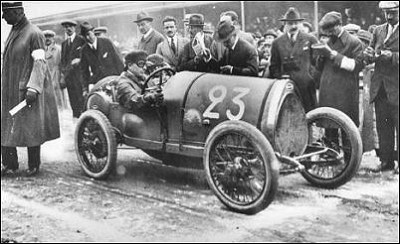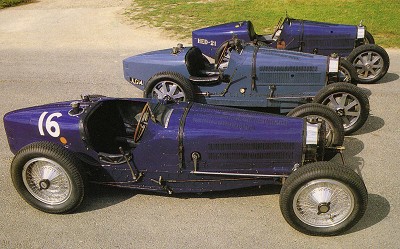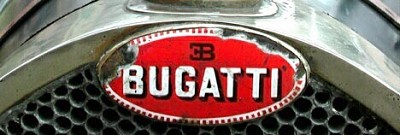The life of Ettore Bugatti, the designer and manufacturer of some of the the finest Grand Prix and sports/touringcars of the 1920s and 1930s, is described, and brief details of some of his classic cars are included.
.jpg)
Early Days
Ettore Bugatti was born in Milan in 1881, the youngest son of Carlo Bugatti, artist and furniture designer. Young Ettore showed a flair for mechanical design, and by the age of 19 had laid out his first gold-medal winning car. This proposed design was sold to Baron de Dietrich from Alsace. Ettore moved to join the Baron in the manufacture of a series of motorcars called de Dietrich-Bugattis. Later he designed the Hermes with Emil Mathis, and became Chief Engineer of Deutz at the age of 25. Wanting to work for himself, he designed his own 1400cc car for the 1910 Paris Automobile show; soon afterwards it went into production. Before World War 1 he created the Type 13, the first car to bear the name Bugatti.
 Bugatti Type 13
Bugatti Type 13
Success
After World War 1, Bugatti continued to build cars such as the lovely Type 23 , and in 1921 his first major success came when the team of 5 Bugatti cars entered for the Voiturette Grand Prix at Brescia took the first 4 places, leading to many orders.

Bugatti Type 23 Brescia at Goodwood
In 1924 Ettore Bugatti designed the car that was to make his name a legend: The Bugatti Type 35, probably the most successful racing car in history, with some 2,000 outright race victories to its credit in all variants. This inspired car was visually a work of art, its flowing lines making the T35 look like ‘ moving sculpture ‘; the rigid frame, beautifully-detailed aluminium body, novel cast-alloy wheels incorporating the brake drums,positive steering, responsive handling and straight-eight 1991cc engine (two blocks of four) were widely admired, and when the supercharged 2.0 litre Bugatti T35C and 2.3 litre Type 35Bs were introduced, the performance was spectacular, sweeping all before them in the years around 1926/1927. About 290 Bugatti Type 35s, 35Bs, 35Cs and 35Ts (unblown 2.3 litre) were made in all between the years 1924 and 1931.


.jpg)
Two Bugatti Type 35Bs and (bottom) Bugatti Type 35 (no breather hole in bonnet)
A T35 for the Public – The ‘Course Imitation’ Tecla:
The success of the T35 on the Grand Prix Circuits led to public demand for a road-going version, and Bugatti soon designed and sold a cheaper (2/3 the price) and slight lower specification replica, which he called The ‘T35A Course Imitation’ The T35A used the standard Grand Prix chassis, axles, gearbox and body, but with a three-bearing crankshaft (instead of five), wire wheels, and no hood – very like the Teal Bugatti! At Molsheim, where the cars were made, and among the general public, the Bugatti T35A soon received the nickname ‘The Tecla’, after a brand of cheaper cultured pearls popular at the time. Ettore Bugatti sold about 135 Course Imitation Tecla T35A sports/racing cars, some 40% of total T35 production at Molsheim.

Bugatti Type 35A Course Imitation ‘Tecla’

As the competition from Alfa Romeo and Maserati, and later Auto Union and Mercedes Benz, increased in the early and middle 1930s, Bugatti and his son Jean continued to design and sell (in limited numbers) innovative and beautiful Grand Prix cars such as the Type 51 and magnificent Type 59, as well as Grand Sport Touring cars such as Type 43, the lovely Type 55, the huge Type 41 Bugatti Royale and handsome Type 57 Atalante.

1933 Type 59 (3.3 litre, supercharged)

1936 Bugatti Type 59

Three Fine Bugattis: T35B (top), T51, T59 (Foreground) Photo: John Colley
Sadly, tragedy struck one evening in August 1939 when Jean, test-driving a supercharged Type 57C before the La Baule Grand Prix on a ‘closed’ section of road between Strasbourg and Molsheim, swerved to avoid a cyclist emerging unexpectedly from a side road; the T57 left the road, the car was wrecked, and Jean Bugatti died instantly in the crash.

Jean Bugatti with Type 44 Fiacre
Ettore Bugatti never really recovered from the death of his son Jean. World War 2 intervened, and after the war he faced a lengthy legal battle with the French authorities to recover control of his factory at Molsheim because of his Italian nationality. He had just won the legal case when he died in August 1947 at the age of 65.

Ettore Bugatti

Please return to the top of the page
Last Updated on 1 year by David Brown
